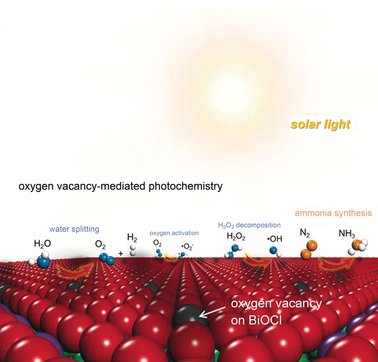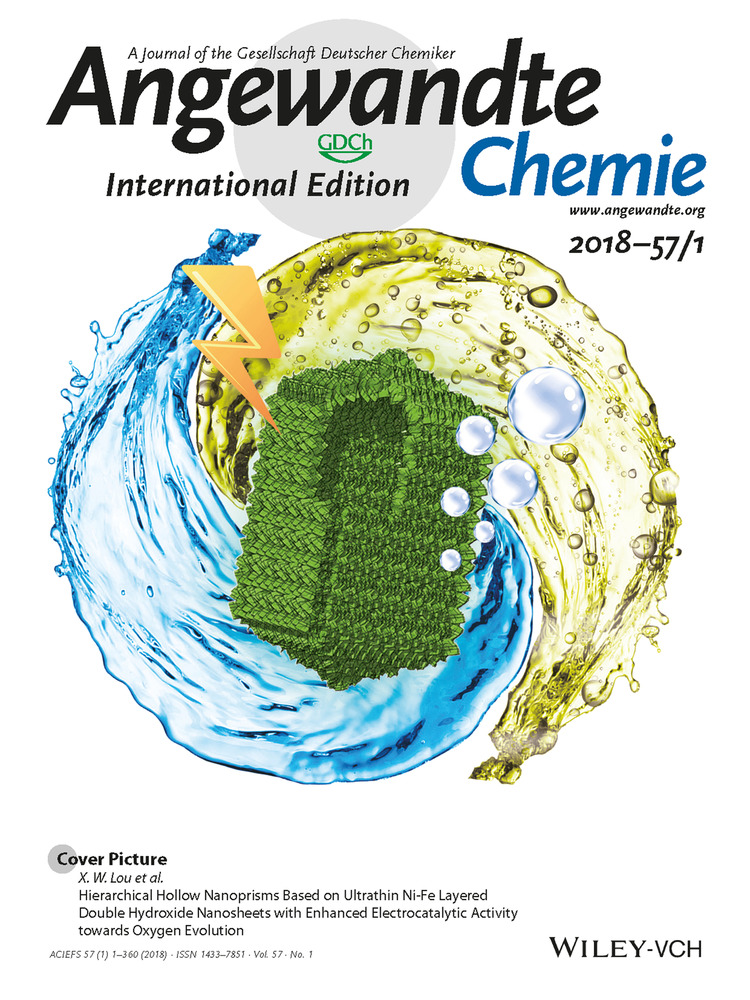Oxygen Vacancy-Mediated Photocatalysis of BiOCl: Reactivity, Selectivity, and Perspectives
Dr. Hao Li
Key Laboratory of Pesticide & Chemical Biology of Ministry of Education, Institute of Environmental Chemistry, College of Chemistry, Central China Normal University, Wuhan, 430079 P.R. China
Search for more papers by this authorDr. Jie Li
Key Laboratory of Pesticide & Chemical Biology of Ministry of Education, Institute of Environmental Chemistry, College of Chemistry, Central China Normal University, Wuhan, 430079 P.R. China
Search for more papers by this authorProf. Zhihui Ai
Key Laboratory of Pesticide & Chemical Biology of Ministry of Education, Institute of Environmental Chemistry, College of Chemistry, Central China Normal University, Wuhan, 430079 P.R. China
Search for more papers by this authorProf. Falong Jia
Key Laboratory of Pesticide & Chemical Biology of Ministry of Education, Institute of Environmental Chemistry, College of Chemistry, Central China Normal University, Wuhan, 430079 P.R. China
Search for more papers by this authorCorresponding Author
Prof. Lizhi Zhang
Key Laboratory of Pesticide & Chemical Biology of Ministry of Education, Institute of Environmental Chemistry, College of Chemistry, Central China Normal University, Wuhan, 430079 P.R. China
Search for more papers by this authorDr. Hao Li
Key Laboratory of Pesticide & Chemical Biology of Ministry of Education, Institute of Environmental Chemistry, College of Chemistry, Central China Normal University, Wuhan, 430079 P.R. China
Search for more papers by this authorDr. Jie Li
Key Laboratory of Pesticide & Chemical Biology of Ministry of Education, Institute of Environmental Chemistry, College of Chemistry, Central China Normal University, Wuhan, 430079 P.R. China
Search for more papers by this authorProf. Zhihui Ai
Key Laboratory of Pesticide & Chemical Biology of Ministry of Education, Institute of Environmental Chemistry, College of Chemistry, Central China Normal University, Wuhan, 430079 P.R. China
Search for more papers by this authorProf. Falong Jia
Key Laboratory of Pesticide & Chemical Biology of Ministry of Education, Institute of Environmental Chemistry, College of Chemistry, Central China Normal University, Wuhan, 430079 P.R. China
Search for more papers by this authorCorresponding Author
Prof. Lizhi Zhang
Key Laboratory of Pesticide & Chemical Biology of Ministry of Education, Institute of Environmental Chemistry, College of Chemistry, Central China Normal University, Wuhan, 430079 P.R. China
Search for more papers by this authorGraphical Abstract
Tiny concentrations of oxygen vacancies on the surface of real photocatalysts can influence the kinetics and energetics and the mechanisms of photocatalytic reactions decisively. Oxygen vacancies on BiOCl surfaces are described at the molecular level, and their structure correlated with reactivity and selectivity in photocatalytic reactions.
Abstract
Semiconductor photocatalysis is a trustworthy approach to harvest clean solar light for energy conversions, while state-of-the-art catalytic efficiencies are unsatisfactory because of the finite light response and/or recombination of robust charge carriers. Along with the development of modern material characterization techniques and electronic-structure computations, oxygen vacancies (OVs) on the surface of real photocatalysts, even in infinitesimal concentration, are found to play a more decisive role in determining the kinetics, energetics, and mechanisms of photocatalytic reactions. This Review endeavors to clarify the inherent functionality of OVs in photocatalysis at the surface molecular level using 2D BiOCl as the platform. Structure sensitivity of OVs on reactivity and selectivity of photocatalytic reactions is intensely discussed via confining OVs onto prototypical BiOCl surfaces of different structures. The critical understanding of OVs chemistry can help consolidate and advance the fundamental theories of photocatalysis, and also offer new perspectives and guidelines for the rational design of catalysts with satisfactory performance.
Conflict of interest
The authors declare no conflict of interest.
References
- 1N. S. Lewis, D. G. Nocera, Proc. Natl. Acad. Sci. USA 2006, 103, 15729.
- 2Q. Xiang, B. Cheng, J. Yu, Angew. Chem. Int. Ed. 2015, 54, 11350; Angew. Chem. 2015, 127, 11508.
- 3Y. Zheng, L. Lin, B. Wang, X. Wang, Angew. Chem. Int. Ed. 2015, 54, 12868; Angew. Chem. 2015, 127, 13060.
- 4S. Bai, J. Jiang, Q. Zhang, Y. Xiong, Chem. Soc. Rev. 2015, 44, 2893.
- 5P. Kofstad, Nonstoichiometry, Diffusion, and Electrical Conductivity in Binary Metal Oxides, Wiley Interscience, 1972.
- 6Y. Liu, C. Xiao, Z. Li, Y. Xie, Adv. Energy Mater. 2016, 1600436.
- 7Y. Sun, S. Gao, F. Lei, Y. Xie, Chem. Soc. Rev. 2015, 44, 623.
- 8J. Nowotny, M. A. Alim, T. Bak, M. A. Idris, M. Ionescu, K. Prince, M. Z. Sahdan, K. Sopian, M. A. M.. Teridi, W. Sigmund, Chem. Soc. Rev. 2015, 44, 8424.
- 9X. Pan, M.-Q. Yang, X. Fu, N. Zhang, Y.-J. Xu, Nanoscale 2013, 5, 3601.
- 10N. Serpone, J. Phys. Chem. B 2006, 110, 24287.
- 11Q. Guo, C. Zhou, Z. Ma, Z. Ren, H. Fan, X. Yang, Chem. Soc. Rev. 2016, 45, 3701.
- 12S. J. Tan, Y. F. Ji, Y. Zhao, A. D. Zhao, B. Wang, J. L. Yang, J. G. Hou, J. Am. Chem. Soc. 2011, 133, 2002.
- 13Y.-F. Li, U. Aschauer, J. Chen, A. Selloni, Acc. Chem. Res. 2014, 47, 3361.
- 14Y. Zhao, W. Ma, Y. Li, H. Ji, C. Chen, H. Zhu, J. Zhao, Angew. Chem. Int. Ed. 2012, 51, 3188; Angew. Chem. 2012, 124, 3242.
- 15X. Lang, W. Ma, C. Chen, H. Ji, J. Zhao, Acc. Chem. Res. 2014, 47, 355.
- 16N. G. Petrik, G. A. Kimmel, J. Phys. Chem. Lett. 2010, 1, 2508.
- 17O. Bikondoa, C. L. Pang, R. Ithnin, C. A. Muryn, H. Onishi, G. Thornton, Nat. Mater. 2006, 5, 189.
- 18R. Schaub, P. Thostrup, N. Lopez, E. Lægsgaard, I. Stensgaard, J. K. Nørskov, F. Besenbacher, Phys. Rev. Lett. 2001, 87, 266104.
- 19W. Pipornpong, R. Wanbayor, V. Ruangpornvisuti, Appl. Surf. Sci. 2011, 257, 10322.
- 20L. Liu, C. Zhao, Y. Li, J. Phys. Chem. C 2012, 116, 7904.
- 21Q. Wu, R. van de Krol, J. Am. Chem. Soc. 2012, 134, 9369.
- 22J. Jiang, K. Zhao, X. Xiao, L. Zhang, J. Am. Chem. Soc. 2012, 134, 4473.
- 23H. Li, L. Zhang, Nanoscale 2014, 6, 7805.
- 24K. Zhao, L. Zhang, J. Wang, Q. Li, W. He, J. J. Yin, J. Am. Chem. Soc. 2013, 135, 15750.
- 25J. Li, Y. Yu, L. Zhang, Nanoscale 2014, 6, 8473.
- 26J. Li, K. Zhao, Y. Yu, L. Zhang, Adv. Funct. Mater. 2015, 25, 2189.
- 27H. Li, J. Shi, K. Zhao, L. Zhang, Nanoscale 2014, 6, 14168.
- 28X. Ding, K. Zhao, L. Zhang, Environ. Sci. Technol. 2014, 48, 5823.
- 29H. Li, J. Shang, H. Zhu, Z. Yang, Z. Ai, L. Zhang, ACS Catal. 2016, 6, 8276.
- 30H. Li, J. Shang, Z. Ai, L. Zhang, J. Am. Chem. Soc. 2015, 137, 6393.
- 31H. Li, J. Shang, J. Shi, K. Zhao, L. Zhang, Nanoscale 2016, 8, 1986.
- 32H. Li, J. Shang, Z. Yang, W. Shen, Z. Ai, L. Zhang, Environ. Sci. Technol. 2017, 51, 5685.
- 33J. Li, G. Zhan, Y. Yu, L. Zhang, Nat. Commun. 2016, 7, 11480.
- 34H. Li, F. Qin, Z. Yang, X. Cui, J. Wang, L. Zhang, J. Am. Chem. Soc. 2017, 139, 3513.
- 35L. Ye, K. Deng, F. Xu, L. Tian, T. Peng, L. Zan, Phys. Chem. Chem. Phys. 2012, 14, 82.
- 36A.-Y. Zhang, T. Lin, Y.-Y. He, Y.-X. Mou, J. Hazard. Mater. 2016, 311, 81.
- 37M. Metz, E. I. Solomon, J. Am. Chem. Soc. 2001, 123, 4938.
- 38Y. Li, W. Zhang, J. Niu, Y. Chen, ACS Nano 2012, 6, 5164.
- 39Z. Liu, W. Hou, P. Pavaskar, M. Aykol, S. B. Cronin, Nano Lett. 2011, 11, 1111.
- 40M. Zhang, Q. Wang, C. Chen, L. Zang, W. Ma, J. Zhao, Angew. Chem. Int. Ed. 2009, 48, 6081; Angew. Chem. 2009, 121, 6197.
- 41Y. Wu, B. Yuan, M. Li, W.-H. Zhang, Y. Liu, C. Li, Chem. Sci. 2015, 6, 1873.
- 42F. E. Osterloh, Chem. Soc. Rev. 2013, 42, 2294.
- 43J. Tang, J. R. Durrant, D. R. Klug, J. Am. Chem. Soc. 2008, 130, 13885.
- 44H. Sheng, H. Zhang, W. Song, H. Ji, W. Ma, C. Chen, J. Zhao, Angew. Chem. Int. Ed. 2015, 54, 5905; Angew. Chem. 2015, 127, 6003.
- 45W.-N. Zhao, Z.-P. Liu, Chem. Sci. 2014, 5, 2256.
- 46L. Zhang, Z. Han, W. Wang, X. Li, Y. Su, D. Jiang, X. Lei, S. Sun, Chem. Eur. J. 2015, 21, 18089.
- 47T. M. El-Morsi, W. R. Budakowski, A. S. Abd-El-Aziz, K. J. Friesen, Environ. Sci. Technol. 2000, 34, 1018.
- 48Y. Mao, C. Schoeneich, K. D. Asmus, J. Phys. Chem. 1991, 95, 10080.
- 49D. W. Gunz, M. R. Hoffmann, Atmos. Environ. Part A 1990, 24, 1601.
- 50M. Pradhan, M. Kalberer, P. T. Griffiths, C. F. Braban, F. D. Pope, R. A. Cox, R. M. Lambert, Environ. Sci. Technol. 2010, 44, 1360.
- 51M. Pradhan, G. Kyriakou, A. T. Archibald, A. C. Papageorgiou, M. Kalberer, R. M. Lambert, Atmos. Chem. Phys. 2010, 10, 7127.
- 52M. W. Chase, Jr., NIST-JANAF Thermochemical Tables, 4th ed., by American Chemical Society, American Institute of Physics, National Bureau of Standards, New York, 1998.
- 53A. E. Shilov, Russ. Chem. Bull. 2003, 52, 2555.
- 54H. P. Jia, E. A. Quadrelli, Chem. Soc. Rev. 2014, 43, 547.
- 55D. R. Dean, J. T. Bolin, L. Zheng, J. Bacteriol. 1993, 175, 6737.
- 56J. Yu, J. Low, W. Xiao, P. Zhou, M. Jaroniec, J. Am. Chem. Soc. 2014, 136, 8839.
- 57N. Zhang, M.-Q. Yang, S. Liu, Y. Sun, Y.-J. Xu, Chem. Rev. 2015, 115, 10307.
- 58N. Zhang, C. Han, Y.-J. Xu, J. J. Foley IV, D. Zhang, J. Codrington, S. K. Gray, Y. Sun, Nat. Photonics 2016, 10, 473.
Citing Literature
January 2, 2018
Pages 122-138





